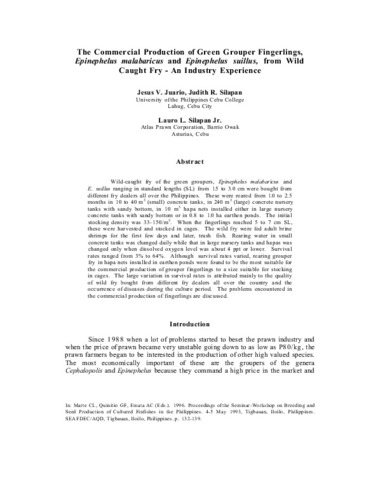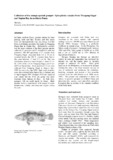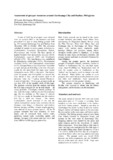The commercial production of green grouper fingerlings, Epinephelus suillus, from wild caught fry - an industry experience
- Global styles
- MLA
- Vancouver
- Elsevier - Harvard
- APA
- Help

Date
1996Page views
5,476ASFA keyword
AGROVOC keyword
Taxonomic term
Metadata
Show full item record
Share
Abstract
Wild-caught fry of the green groupers, Epinephelus malabaricus and E. suillus ranging in standard lengths (SL) from 1.5 to 3.0 cm were bought from different fry dealers all over the Philippines. These were reared from 1.0 to 2.5 months in 10 to 40 m3 (small) concrete tanks, in 240 m3 (large) concrete nursery tanks with sandy bottom, in 10 m3 hapa nets installed either in large nursery concrete tanks with sandy bottom or in 0.8 to 1.0 ha earthen ponds. The initial stocking density was 33-150/m3. When the fingerlings reached 5 to 7 cm SL, these were harvested and stocked in cages. The wild fry were fed adult brine shrimps for the first few days and later, trash fish. Rearing water in small concrete tanks was changed daily while that in large nursery tanks and hapas was changed only when dissolved oxygen level was about 4 ppt or lower. Survival rates ranged from 3% to 64%. Although survival rates varied, rearing grouper fry in hapa nets installed in earthen ponds were found to be the most suitable for the commercial production of grouper fingerlings to a size suitable for stocking in cages. The large variation in survival rates is attributed mainly to the quality of wild fry bought from different fry dealers all over the country and the occurrence of diseases during the culture period. The problems encountered in the commercial production of fingerlings are discussed.
Suggested Citation
Juario, J. V., Silapan, J. R., & Silapan Jr., L. L. (1996). The commercial production of green grouper fingerlings, Epinephelus suillus, from wild caught fry - an industry experience. In C. L. Marte, G. F. Quinitio, & A. C. Emata (Eds.), Proceedings of the Seminar-Workshop on Breeding and Seed Production of Cultured Finfishes in the Philippines, Tigbauan, Iloilo, Philippines, 4-5 May 1993 (pp. 132-139). Tigbauan, Iloilo, Philippines: Aquaculture Department, Southeast Asian Fisheries Development Center.
Type
Conference paperISBN
9718511326
Related items
Showing items related by title, author, creator and subject.
-
Philippine National Standard: Live, chilled/frozen grouper
Bureau of Agriculture and Fisheries Standards (Bureau of Agriculture and Fisheries Standards, 2009)This Philippine National Standard for live, chilled/frozen grouper identifies the Philippine species of grouper, specifies their essential composition and quality factors (including size classification and quality ... -
Collection of the orange-spotted grouper Epinephelus coioides from Tinagong Dagat and Sapian Bay in northern Panay
Solis, Noel B. (Bureau of Agricultural Research, Department of Agriculture, 2007)In Capiz, northern Panay, grouper catches by hand picking, hook and line, shelters, and fish corral were low throughout the year, on average 1-3 fish from each fishing operation, but higher in Tinagong Dagat than in Sapian ... -
Assessment of grouper resources around Zamboanga City and Basilan, Philippines
Lasola, N. T.; Samson, R. A.; Domingo, P. B. (Bureau of Agricultural Research, Department of Agriculture, 2007)A total of 2,643 kg of groupers were collected from six markets (96% of the biomass) and from prescribed fish traps in three fishing grounds (106 kg, 4%) around Zamboanga City and Basilan from November 1993 to October 1994. ...






